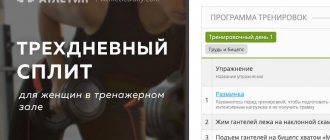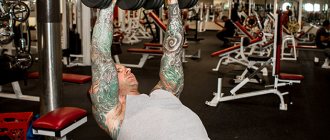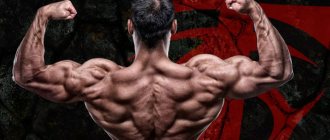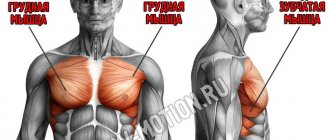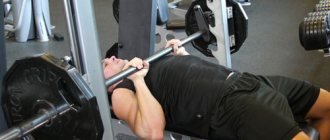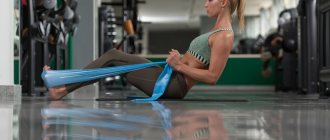Features of this program and tips
- helps the development of slow muscle fibers - through the use of a large number of repetitions. This type of fiber does not add much to muscle mass, but it does help develop their overall strength and endurance. What is often used to overcome “stagnation”
- During a pumping workout, a large amount of blood entering the muscles brings a large amount of microelements that will help you work better during the workout itself, as well as recover faster
- Try to perform each exercise with concentration, without rushing. Imagine how your muscles work. This will help you get the maximum benefit from pumping.
- Pumping workouts require a lot of energy - to avoid muscle breakdown, drink a protein-carbohydrate shake before the workout itself, as well as before the cool-down.
Comments on the exercises
- All the exercises that make up this program (except for the last ones in the training day) are connected into supersets - first you need to complete a set of the first exercise, rest for 10-30 seconds (or not stop at all) and move on to the second. After completing a combination of 2 exercises, you can rest for 1-2 minutes.
- The exercises were selected taking into account supersets - lying dumbbell flyes and seated dumbbell presses are performed with the same dumbbells on an incline bench.
- When performing push-ups, hyperextensions, and pull-ups, use weights if the load is too easy for you.
Don't forget that you can edit this and any other training program using a convenient tool on our website - the workout editor.
Source
Additives for pumping
Pumping is a very energy-intensive thing, so various sports supplements are used. When choosing energy drinks for bodybuilding, not only the degree of increase in strength indicators is taken into account, but also the level of muscle pumping with water. This indicator should be minimal, because the goal of the exercise is to achieve relief and, accordingly, reduce water content in the tissues.
When consuming creatine, endurance and strength increase significantly. Its use is a very common way to stimulate the body .
However, it is contraindicated for terrain training, because it floods heavily with water. Bodybuilders use organic nitrates as a substitute, of which, in particular for pumping, the most popular is arginine. It stimulates the body and gives a strong surge of energy. The use of various drugs for fat burning is also practiced. Pumping in bodybuilding
How to pump up arm muscles: pumping style training for biceps and triceps.
Today we will talk about a workout that will allow you to pump up your arms as much as possible, or rather your biceps and triceps. I would even say that this workout is aimed at “killing” your arms. No matter how surprising it may seem to you, our training will be built on the basis of “pumping”.
What is “pumping” and why is it needed? “Pumping” is training in which a significant number of repetitions are performed in each set. Training in the “pumping” style provides simply unrealistic blood supply to the working muscles, which allows you to increase the number and diameter of blood vessels that intertwine bundles of muscle fibers and ultimately affect muscle volume. Retention of blood in working muscles also increases the release of growth factors into the blood, which, again, can have a positive effect on muscle growth.
Another positive point is that high-repetition training allows you to recruit slow-twitch muscle fibers (type I fibers), which are unlikely to be “loaded” in any other way. “Pumping” can be considered a panacea for those with “slow” fibers predominant in one muscle group or another (people with type I fibers predominating in all muscle groups are very rare). Finally, “pumping” is used at the stage of working on muscle relief.
A significant disadvantage of “pumping” is that it has a minimal effect on the hypertrophy of “fast” muscle fibers (it would be more accurate to say that it has almost no effect at all), so it’s hardly worth “focusing” only on this training method. But today we will train in the “pumping” style.
Only a bench and barbell and dumbbells will be used; we will try to do without exercise equipment. That is, our training program is also suitable for those who do not have the opportunity to visit a gym, but have a minimum set of equipment at home.
Number of sets and repetitions We will combine two exercises - for biceps and triceps - into supersets; In total, there will be two different supersets in our workout. During the workout we will perform 3 supersets No. 1 and 2-3 supersets No. 2. We will try to perform 15 repetitions in each exercise.
On the subject: Standing dumbbell curls with a hammer
An important detail: we will not rest between exercises combined into a superset, nor - attention! – between the supersets themselves. Moreover, we will not rest while moving from the first superset to the second. This is done in order to maximize blood supply to the muscles - blood should not leave the working muscles at all.
As a result, the training turns out to be very short - this is another advantage of it, but very effective.
Arm curls with a barbell while sitting at a semi-inclination We sit on a bench, take the barbell in our hands with a wide grip, lean a little forward and rest our elbows on the inner surface of our thighs. We perform arm curls - 15 repetitions per set. In fact, this exercise is an analogue of arm curls on the lower block. To prevent the bar from touching the floor, rise on your toes.

Arm extensions with a barbell from behind the head Having “pumped up” the biceps well, we move on to the triceps exercise - without the slightest break. This exercise is performed with maximum amplitude - the arms are fully straightened and fully bent. Performing this style of exercise with heavy weights would be too dangerous for the elbows, but pumping does not involve the use of heavy weights.
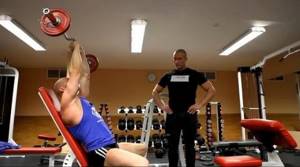
Attention: there should be no pause between supersets - having completed the exercise for one muscle group, we immediately move on to training the antagonist group. A total of 2-3 supersets are performed.
Concentrated arm curls with a dumbbell We take a dumbbell in our hand, sit on a bench, rest our elbow on the inner surface of the thigh. We perform bending, trying to work in maximum amplitude. The body should never be tilted back at the top point of the range of motion, otherwise the load will be removed from the biceps. Bend forward at the lowest point of the amplitude should also not be done - the hand with the dumbbell lowered down should be perpendicular to the floor. The brush also needs to be kept motionless.
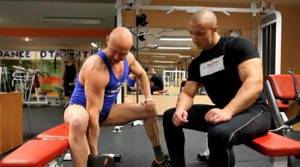
Having completed the exercise with one hand, immediately move on to the second. We try to perform 15 repetitions for each hand.
Triceps push-ups from a bench Immediately after a set of concentrated curls, do push-ups from a bench. We rest against the bench from behind, place our legs slightly bent at the knees on a hill and begin to do push-ups, without moving the pelvis far from the bench and trying to keep the body as close to a vertical position as possible. After completing the maximum possible number of repetitions, place your bent legs on the floor and continue doing push-ups.
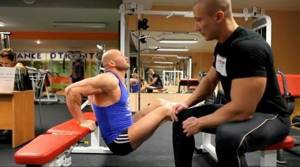
Once again, we do not rest either between the exercises that make up the superset, or between the supersets themselves. We perform three such supersets in total.
How do you feel after training? They must be just great! It’s not for nothing that Arnold Schwarzenegger said that after a “pumping” arm workout he feels like God.
Source
Pumping - what is it, rules and training program
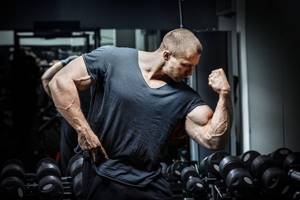
Pumping (from the English verb to pump - “pump up”) is a training method aimed at maximizing blood supply to the muscles and their maximum increase in volume during the training process. Pumping training is practiced mainly by bodybuilders, but athletes of other strength sports will also find certain advantages in them. We will tell you which ones exactly in this article.
What is pumping?
Pumping, that is, pumping muscles with blood, gives an unforgettable sensation - this is the most obvious advantage of the described technique. It's nice to look at your enlarged muscles, observing the effect here and now.
How to achieve pumping?
How is this achieved? What is the essence of pumping style training?
- In the pumping style, as a rule, no more than two muscle groups are worked out in one workout.
- The exercises chosen are mainly isolating ones, that is, those in which one muscle group works. Give preference to those movements in which you feel this small muscle group as well as possible.
- The weight is selected in such a way that in one approach you get at least 15 “clean” repetitions, preferably more, up to 20-25. “Cleanliness” is extremely important - the technique must be perfect, the feeling of work must be only in the target muscle group! Accordingly, each repetition is performed under control.
- At the end of each approach, you should feel a pronounced burning sensation in the target muscle. The maximum burn will be the limiting factor on the way to completing the next repetition. To fulfill this condition, avoid the “extreme point” in the exercise - complete relaxation of the muscle (for example, do not fully extend your arms in presses or when doing biceps curls), which should always be in good shape.
- It is not necessary to fix the muscle during peak contraction, although it is quite possible, thereby achieving even greater difficulty in the outflow of blood from the working muscle and, accordingly, an even greater pump effect.
- In addition to the simplest option with performing the exercise for 15-25 repetitions, there are several more complex schemes that help achieve the same blood supply to the muscles: supersets, drop sets, concentration on the negative phase of the movement, etc. The optimal option would be to include several in the complex similar schemes or alternate them to give the muscles a new stress each workout.
On the subject: Exercises for rapid growth of arm muscles
The benefits of pumping
The point of all of these actions is to maximize blood flow to the muscle, while at the same time reducing the outflow. This leads to oxygen debt and acidosis - acidification of muscle fiber. Acidification is due to the fact that if the outflow of blood is disrupted, the inflow also slows down, which means that oxygen does not have time to reach the working muscle in the required quantity.
To provide the working fiber with energy, cells switch to the anaerobic, that is, oxygen-free path of oxidative phosphorylation or energy production - ATP. During the oxygen-free pathway of energy production, metabolic by-products are formed - hydrogen ions. They are the ones who change the environment inside the cell. From a biological point of view, this damages the quaternary structure of the protein of the cell nucleus, which makes it easier for anabolic hormones to access it. It is thanks to the action of hormones at the cellular level that our muscles grow and recover faster.
However, do not forget that when pumping, a small working weight will be used (otherwise you will not be able to complete the specified number of repetitions), which will be a much smaller stimulus for muscle growth than with classical training. A small increase in the flow of hormones to muscle fibers is not a sufficient factor for successful mass gain.
Types of pumping training
Pumping programs involve multiple repetitions of exercises. This method can be used for all muscles. There are three ways to effectively “pump” your muscles:
- high-repetition training;
- superset.
High-repetition workouts are great for beginner athletes or just those who are not involved in professional sports. This exercise is characterized by a fast pace of execution and a short duration of the total number of approaches. The average repetition range for exercises is 15–20. It is recommended to rest no more than 2 minutes between approaches.
If multiple repetitions are performed by experienced bodybuilders, it is recommended to use split - a special way to pump up the muscle. The program is divided into several days, where each training day is intended to work with only one group. For example, on Monday you pump your chest and do all the exercises to pump up your chest. On Tuesday, the biceps are pumped, so only biceps exercises are performed.
One superset consists of several exercises that can work either one muscle group or different ones. Each exercise in one set is performed in only one approach. The transition to the next one occurs immediately without stopping. A series of sets are applied to the antagonist muscle group, which then recovers faster after training. While one muscle group is tense, the previous one is resting, which ultimately leads to better results. Drop sets are often used - a system of exercises with weight loss.
Pumping rules
An additional condition for pumping training is a reduced rest time between approaches (no more than a minute, ideally 30-40 seconds) . This increases muscle motor density and leads to increased energy expenditure.
High intensity pumping style training results in increased energy consumption. Accordingly, the energy resources of the cell are quickly depleted. In the process of systematic training in the described style, the ability of muscle cells to store glycogen increases. Your muscles will have large volumes due to this phenomenon.

Sports nutrition for muscle pumping
The main sports supplement for pumping is arginine.
This amino acid is a source of nitric oxide NO, which increases blood flow by dilating blood vessels. As a result of taking such a “nitrogen dispenser,” more blood enters the muscles and the muscles become visually larger. Arginine is included in most pre-workout boosters. When using such supplements 20-30 minutes before the start of a workout, mental focus increases, strength indicators increase and additional pumping of the muscles with blood occurs (which, in essence, is what pumping is).

Training rules for effectively pumping biceps - why is exercise technique more important than heavy working weight?
Training recommendations
If you use only pumping in training, progress in muscle growth will be noticeably inferior to classical and strength training approaches. This is especially true for natural athletes. However, there is no need to throw out this scheme altogether - you just need to cycle the loads correctly . For example, the first week perform exercises in the classic mode - 10-12 repetitions, the second week use pumping and work for 15-25 repetitions, the third week return to the classics again, and so on.
Another working scheme for such cycling is as follows:
- The first week is strength training in the style of powerlifting. Only heavy basic exercises with free weight are used, the number of repetitions is from 3 to 8-10.
- Second and third weeks. The classic bodybuilding approach is 8-12 reps. The base is the base, a little insulation is added.
- The fourth week is pumping. 15-25 reps, you can use supersets, drop sets, pre-exhaustion and other similar techniques. The exercises are mostly isolation exercises.
Finally, a recommendation based on the works of V.N. Seluyanov. When performing a training plan within the same pump workout, the load on the same muscle group will be excessive. Acidification can be so strong that instead of spurring anabolic processes in the muscle fiber, it stimulates pronounced catabolism, and instead of building new muscle volumes, you will spend a long time and tediously restoring what you had before the workout.
To avoid this unpleasant phenomenon, the best option for building a pumping-style workout would be to alternate exercises on muscle groups anatomically separated from each other.
For example, you are pumping up your biceps. Between sets of curls, you do squats to remove some of the free radicals from the muscle fiber. Of course, with this approach, the pumping effect is more difficult to achieve, but you will be sure that you did not work out in the negative during the training. Again, such an approach will additionally increase the endurance of the muscle groups being worked - this will occur due to the growth of mitochondrial mass. Namely, mitochondria are responsible for the utilization of oxygen and the production of energy by muscle fiber.
On topic: How to make dice with your own hands
